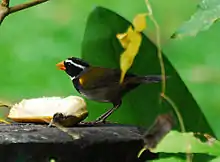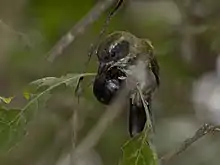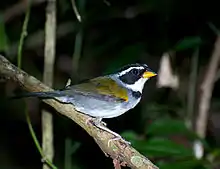Arremon
Arremon is a genus of neotropical birds in the family Passerellidae. With the exception of the green-striped brushfinch which is endemic to Mexico, all species are found in South America, with a few reaching Central America.
| Arremon | |
|---|---|
 | |
| Orange-billed sparrow (Arremon aurantiirostris) | |
| Scientific classification | |
| Kingdom: | Animalia |
| Phylum: | Chordata |
| Class: | Aves |
| Order: | Passeriformes |
| Family: | Passerellidae |
| Genus: | Arremon Vieillot, 1816 |
| Type species | |
| Tanagra taciturna Hermann, 1783 | |
These sparrows are found in lowland woodlands and forests where they usually forage on the ground. They have olive or grey upperparts with a black head. Many have a white line above the eye and some have a black band across the breast.[1]
Taxonomy
The genus Arremon was erected in 1816 by the French ornithologist Louis Jean Pierre Vieillot in his Analyse d'une Nouvelle Ornithologie Élémentaire to accommodate the pectoral sparrow (Arremon taciturnus).[2] The name is from the Ancient Greek arrhēmōn meaning "silent" or "without speech".[3] The pectoral sparrow had been given the French name "L'Oiseau Silencieux" by the polymath Georges-Louis Leclerc, Comte de Buffon in 1779.[4][5]
The genus contains 20 species.[6][7]
| Image | Scientific name | Common Name | Distribution |
|---|---|---|---|
| Arremon crassirostris | Sooty-faced finch | Costa Rica, Panama and far northwestern Colombia | |
.jpg.webp) | Arremon castaneiceps | Olive finch | Colombia, Ecuador and far northern Peru |
 | Arremon brunneinucha | Chestnut-capped brushfinch | central Mexico to southeastern Peru. |
 | Arremon virenticeps | Green-striped brushfinch | Mexico |
| Arremon atricapillus | Black-headed brushfinch | Colombia and Panama | |
| Arremon costaricensis | Costa Rican brushfinch | Panama and Costa Rica | |
| Arremon basilicus | Sierra Nevada brushfinch | northern Colombia | |
.jpg.webp) | Arremon perijanus | Perija brushfinch | northeast Colombia and northwest Venezuela |
| Arremon phaeopleurus | Caracas brushfinch | Venezuela | |
| Arremon phygas | Paria brushfinch | Venezuela | |
_(22654443455).jpg.webp) | Arremon assimilis | Grey-browed brushfinch | Venezuela, Colombia, Ecuador, and most of Peru. |
.jpg.webp) | Arremon torquatus | White-browed brushfinch | Argentina, Bolivia, and southern Peru |
 | Arremon aurantiirostris | Orange-billed sparrow | Belize, Costa Rica, Guatemala, Honduras, Mexico, Nicaragua and Panama |
 | Arremon taciturnus | Pectoral sparrow | Bolivia, Brazil, Colombia, French Guiana, Guyana, Peru, Suriname, and Venezuela. |
| Arremon franciscanus | São Francisco sparrow | Rio São Francisco and in the states such as Bahia and Minas Gerais, Brazil | |
 | Arremon semitorquatus | Half-collared sparrow | southeastern Brazil. |
| Arremon dorbignii | Stripe-crowned sparrow | base of the Andes, from eastern Bolivia to northwest Argentina | |
| Arremon schlegeli | Golden-winged sparrow | Colombia and Venezuela. | |
.jpg.webp) | Arremon abeillei | Black-capped sparrow | Ecuador and Peru |
.jpg.webp) | Arremon flavirostris | Saffron-billed sparrow | Argentina, Bolivia, Brazil, and Paraguay |
This genus includes species traditionally placed in Buarremon and Lysurus.[8][9][10]
References
- Ridgely, Robert S.; Tudor, Guy (2009). Birds of South America: Passerines. Helm Field Guides. London: Christopher Helm. p. 641. ISBN 978-1-408-11342-4.
- Vieillot, Louis Jean Pierre (1816). Analyse d'une Nouvelle Ornithologie Élémentaire (in French). Paris: Deterville/self. p. 32.
- Jobling, James A. (2010). The Helm Dictionary of Scientific Bird Names. London: Christopher Helm. p. 56. ISBN 978-1-4081-2501-4.
- Buffon, Georges-Louis Leclerc de (1780). "L'Oiseau Silencieux". Histoire Naturelle des Oiseaux (in French). Volume 7. Paris: De l'Imprimerie Royale. pp. 429–430.
- Paynter, Raymond A. Jr, ed. (1970). Check-List of Birds of the World. Volume 13. Cambridge, Massachusetts: Museum of Comparative Zoology. p. 182.
- Gill, Frank; Donsker, David; Rasmussen, Pamela, eds. (2020). "New World Sparrows, Bush Tanagers". IOC World Bird List Version 10.1. International Ornithologists' Union. Retrieved 31 May 2020.
- "Species Updates – IOC World Bird List". Retrieved 2021-01-12.
- Cadena, C.D.; Klicka, J.; Ricklefs, R.E. (2007). "Evolutionary differentiation in the Neotropical montane region: Molecular phylogenetics and phylogeography of Buarremon brush-finches (Aves, Emberizidae)". Molecular Phylogenetics and Evolution. 44 (3): 993–1016. doi:10.1016/j.ympev.2006.12.012.
- Cadena, Carlos Daniel; Cuervo, Andrés M. (2010). "Molecules, ecology, morphology, and songs in concert: how many species is Arremon torquatus (Aves: Emberizidae)?". Biological Journal of the Linnean Society. 99 (1): 152–176. doi:10.1111/j.1095-8312.2009.01333.x.
- Donegan, T.M.; Avendaño-C, J.E.; Briceño-L, E.R.; Huertas, B. (2007). "Range extensions, taxonomic and ecological notes from Serranía de los Yariguíes, Colombia's new national park": 172–212. Cite journal requires
|journal=(help)